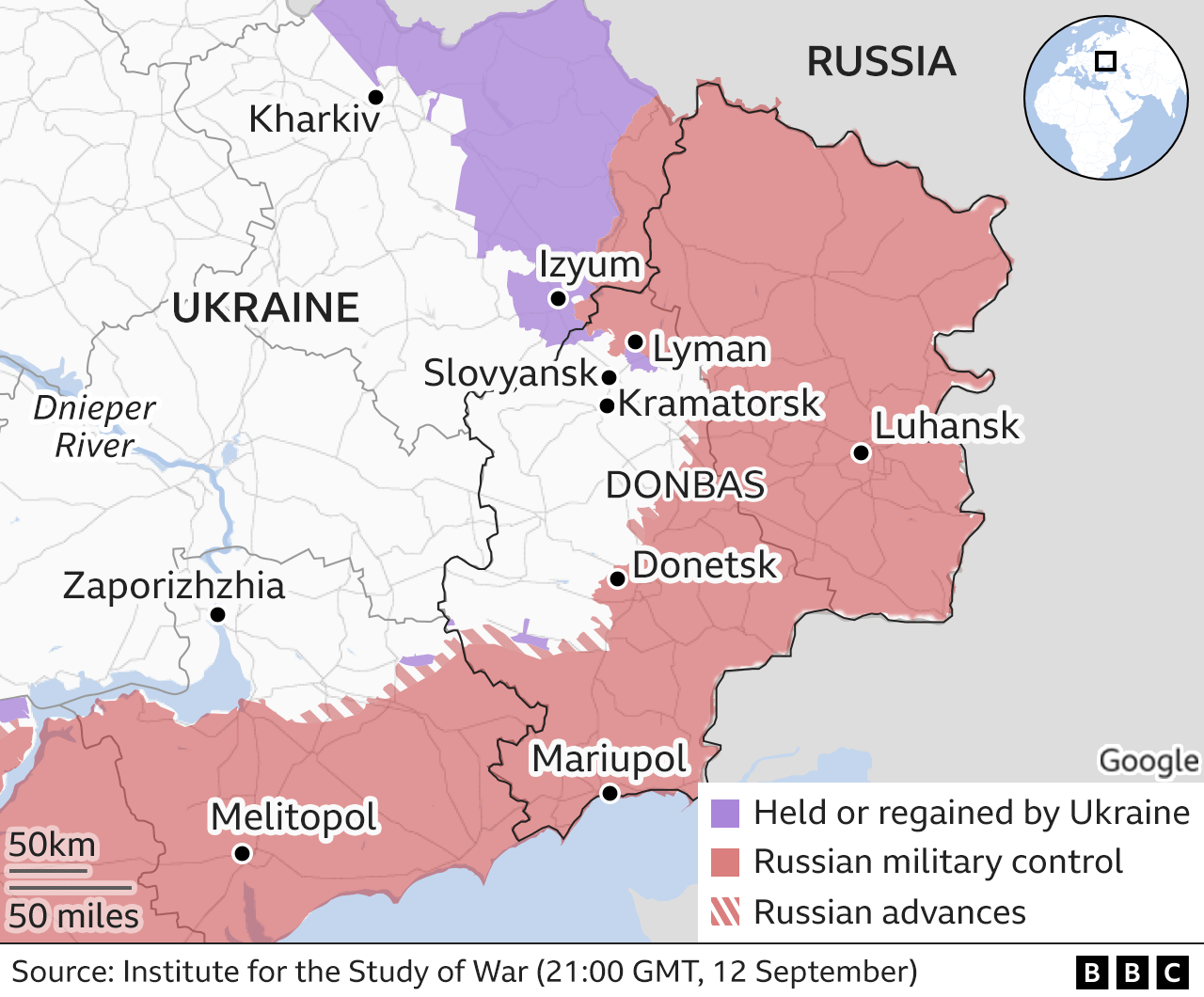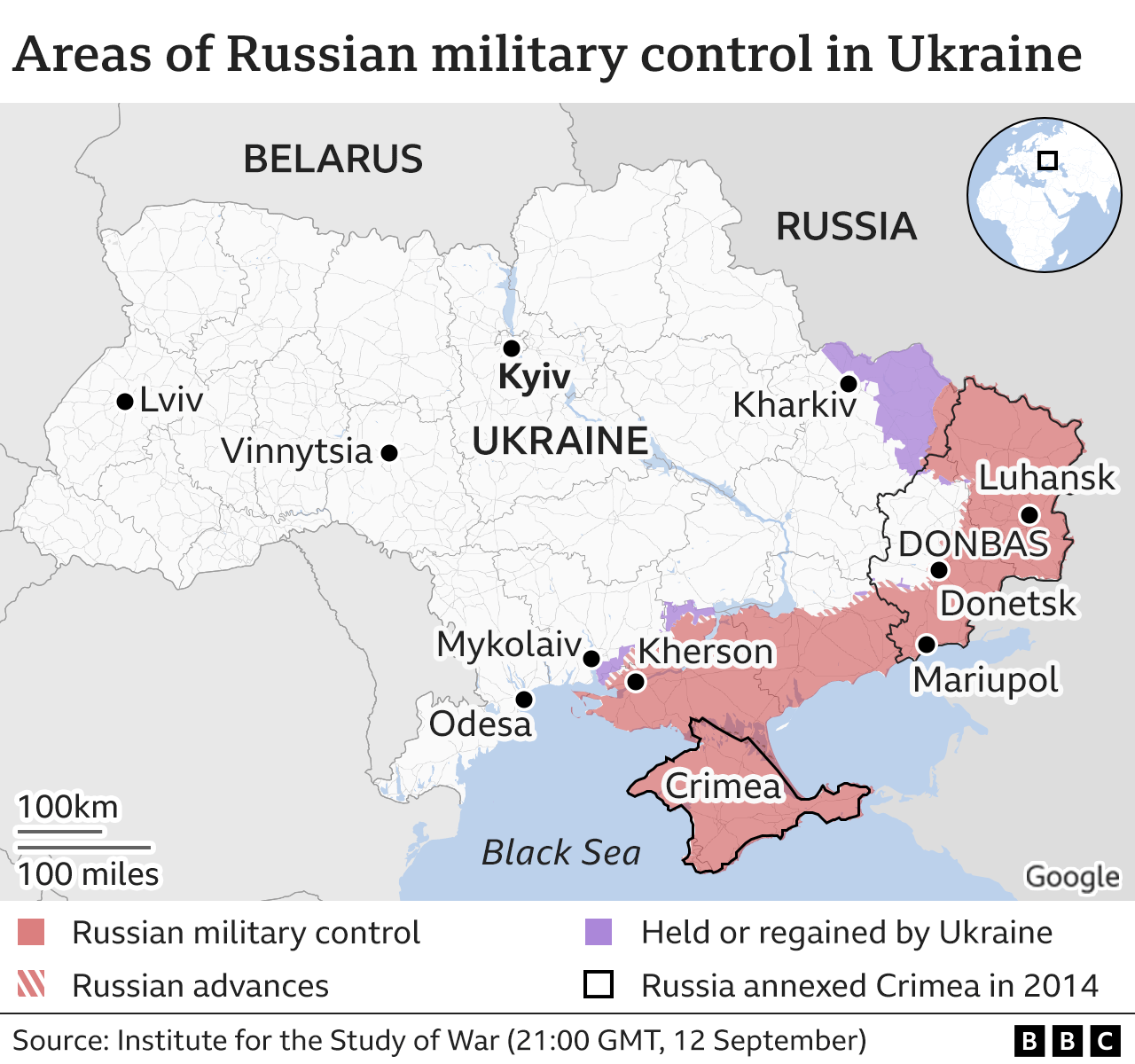BBC News 14 September 2022 - by the Visual Journalism Team
A Ukrainian counter-attack has forced Russian troops into a rapid retreat.
Here are the latest developments:
- Ukraine says it has retaken more than 6,000 sq km (2,317 sq miles) from Russian control in September
- In the Kharkiv region, the towns of Izyum and Kupiansk, both key hubs for the supply of Russian forces in Donbas, were taken by Ukraine on Saturday
- A Ukrainian counterattack in Kherson in the south continues
- Russia still holds about a fifth of the country, but the Russian retreat is being seen by many analysts as a very significant Ukrainian success
Russians retreat in the east
Ukrainian troops have inflicted a "major operational defeat" on Russian forces, according to the Institute for the Study of War (ISW).
Russia confirmed it had withdrawn from the key towns of Izyum and Kupiansk on Saturday, saying that the retreat would allow its troops to "regroup".
Both towns were major logistical hubs for Russian forces in Donbas. Russian troops had been trying to advance towards Kramatorsk and Slovyansk.
Izyum in particular was one of the most fortified sections of the Russian front line.
On Tuesday, Ukrainian President Volodymyr Zelensky said troops had retaken more than 6,000 sq km (2,317 sq miles) from Russian control in September, in the east and the south.
Justin Bronk of the Royal United Services Institute (Rusi) told the BBC that Russian positions in Kharkiv had suffered a "total collapse."
The Russian withdrawal was, he said, "certainly the most dramatic reverse that we've seen from the Russians since they retreated from Kyiv in April".
The ISW said Ukraine now controls almost all of the Kharkiv region and the advance had ended the prospect that Russia could capture the whole of Donbas in the current stage of the war.
Previously, Russian officials had said their forces were fighting for the "complete liberation" of the Donbas, which broadly refers to Ukraine's eastern regions of Donetsk and Luhansk, where Russian-backed separatists held significant territory before the invasion.
Reports suggest that Russian positions are also under attack in Lyman, to the east of Slovyansk.
Prof Michael Clarke of King's College London told the BBC the Russians had suffered a "major intelligence failure" in Kharkiv, underestimating the strength of Ukrainian forces and their capacity to rotate fresh troops to and from the front lines.
On Monday, Vitaly Ganchev, Russia's top official in Kharkiv told Russian TV that Ukrainian forces outnumbered Russians by eight to one in their counter-attack.
Many analysts similarly argue that Russian forces had left key positions exposed, sending too many troops to the Kherson area in the south, where they face another Ukrainian counter-offensive.
Ukrainian counter-attack in the south
Ukraine says it has continued to attack Russian positions near Kherson, targeting Russian transportation and logistics facilities.
Reports suggest Ukrainian troops have made gains at several locations on the Russian front line in recent weeks.
They have also attacked bridges, ferries and pontoons, attempting to make Russian positions of the west side of the Dnieper River unsustainable, and thereby force a withdrawal.
The ISW says Russian forces now face a "terrible dilemma".
Lacking resources to fight effectively in the east, they need to decide whether to send troops back to the front line near Kharkiv from Kherson in the south.
But they know that by doing so, they may compromise their positions near Kherson and risk defeat.
Ukraine's counter-attack is having "significant impacts on Russian morale and military capabilities in southern Ukraine", it says.
Also in the south, the International Atomic Energy Agency (IAEA) has called for the demilitarisation of the Zaporizhzhia nuclear power plant.
Russian and Ukrainian sources have accused each other of shelling close to the plant, which is Europe's biggest nuclear facility.
Russia's military took over the power station in early March, but it is still being operated by Ukrainian staff.
The Zaporizhzhia region, along with Kharkiv, Donetsk and Sumy, has suffered blackouts in recent days.
Mr Zelensky has blamed Russia for the power cuts.
Western weapons boost Ukraine
Mr Zelensky has appealed for more funding and equipment to retain the areas retaken from Russia in recent days.
Western shipments of weaponry are being used heavily by Ukrainian forces.
Early in the conflict Ukraine used primarily Warsaw Pact munitions, which they had been using for several decades.
But many units have now made the transition to Nato standard equipment, including artillery and ammunition.
Multiple launch rocket systems such as the US-made Himars have been used in both Kharkiv and Kherson, according to the ISW.
Mr Zelensky says: "Our main goal is to de-occupy our whole territory."
Russia invaded Ukraine on 24 February, but Ukrainian forces retook large areas around Kyiv in early April after Russia abandoned its push towards the capital.
Areas in the west of the country, including Lviv, have seen missile attacks but no attempt by Russian forces to take and occupy ground.
The Russians have suffered heavy losses since the invasion began and significant quantities of Russian weaponry have also been destroyed or captured.
By David Brown, Bella Hurrell, Dominic Bailey, Mike Hills, Lucy Rodgers, Paul Sargeant, Alison Trowsdale, Tural Ahmedzade, Mark Bryson, Zoe Bartholomew, Sean Willmott, Sana Dionysiou, Joy Roxas, Gerry Fletcher, Jana Tauschinsk, Debie Loizou, Simon Martin and Prina Shah.
About these maps
To indicate which parts of Ukraine are under control by Russian troops we are using daily assessments published by the Institute for the Study of War with the American Enterprise Institute's Critical Threats Project.
To show key areas where advances are taking place we are also using daily updates from the UK Ministry of Defence and BBC research.
The situation in Ukraine is fast moving and it is likely there will be times when there have been changes not reflected in the maps.






